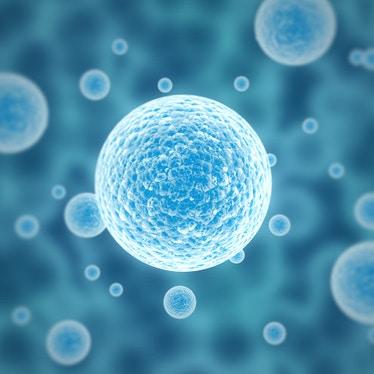Cell Signaling Research Reagents
Intracellular protein detection is used to study signaling pathways, also known as signal transduction cascades, and plays a key role in sensing and integrating diverse external stimuli to generate biological responses. These stimuli are detected by cell surface receptors, which transmit the initial signal inside the cell. This signal is then amplified by a transduction cascade mediated by the phosphorylation of multiple protein substrates.
Protein phosphorylation is a dynamic process, tightly controlled by kinase and phosphatase cascades, which regulate many cellular processes and have been identified as underlying mechanisms for a variety of diseases.
The flexibility and robustness of HTRF™ and AlphaLISA™ SureFire® Ultra™ technologies make them ideal choices for researchers focused on cell signaling and intracellular phosphorylated proteins, offering a streamlined approach to pathway analysis.

HTRF for pathway analysis
Intracellular signaling pathways, or signal transduction cascades, are essential for cells to sense and respond to various external signals like growth factors, hormones, cytokines, and stress. These pathways trigger biological responses such as enzyme activity changes, gene expression, and cytoskeletal adjustments, leading to critical cellular functions including proliferation, migration, differentiation, and nutrient metabolism.
HTRF cell-based phosphorylated and non-phosphorylated protein level immunoassay kits offer a rapid and streamlined alternative to traditional technologies such as Western blot, ELISA, and other luminescent bead-based assays.
Following treatment, cells undergo lysis, releasing intracellular proteins, both phosphorylated and unphosphorylated, from the cell compartments. The released proteins are then detected by adding the appropriate reagents.
All HTRF phospho and total assays are based on a sandwich immunoassay format
The HTRF phosphorylated protein immunoassay uses two antibodies: one labeled with a donor fluorophore and the other with an acceptor. The first antibody is selected for its specific binding to the phosphorylated motif on the protein, while the second antibody recognizes the protein independently of its phosphorylation state.
The HTRF total protein immunoassay also uses two labeled antibodies, one coupled to a donor fluorophore and the other to an acceptor. Both antibodies are highly specific for distinct epitopes on the protein.
Due to the sandwich format of HTRF intracellular phosphorylated and total assays, the HTRF signals increase proportionally to the concentration of the protein of interest.

The proper optimization of assay conditions is essential to achieve the best reagent use and performance. Our guide offers the latest guidelines for optimizing cell signaling assays, ensuring you stay at the forefront of scientific research. With over 300 kits available, you will find the perfect solution for your specific needs.
AlphaLISA SureFire Ultra, Multiplex SureFire Ultra and AlphaLISA SureFire Biotin Free
AlphaLISA SureFire Ultra for quantifying phosphorylation events in cellular assays
AlphaLISA SureFire Ultra assay kits allow the rapid, sensitive, and quantitative detection of phosphoproteins from cells. The AlphaLISA SureFire Ultra assay kits are optimized for enhanced signal-to-noise windows.
AlphaLISA assays require two bead types: Donor beads and Acceptor beads. In AlphaLISA SureFire Ultra, the Donor bead is coated with streptavidin to capture the biotinylated antibody while the Acceptor bead is coated with a proprietary "CaptSure™" agent that immobilizes the other antibody which is labeled with a CaptSure tag.
In the presence of phosphorylated protein, the two antibodies bring the Donor and Acceptor beads in close proximity, whereby the singlet oxygen transfers energy to excite the Acceptor bead, enabling the generation of a luminescent Alpha signal. The amount of light emission is directly proportional to the quantity of phosphoprotein present in the sample.

In addition to AlphaLISA SureFire Ultra kits detecting phosphorylated proteins, there is a subset of AlphaLISA SureFire Ultra kits that allow for the detection of the "total" analyte (i.e. non-phosphorylated as well as phosphorylated), offering an ideal way to normalize for positive or negative modulation of protein expression in cellular contexts.
Simultaneous detection of phosphorylated and non-phosphorylated with Multiplex assays
Multiplex SureFire Ultra (MPSU) kits are complete kits for phospho and total detection of the same target. Assessing the total protein level (phosphorylated and non-phosphorylated) is essential in distinguishing whether up- or down-regulation of phosphorylation is due to changes in that protein's expression levels or to cell viability.

AlphaLISA SureFire Biotin Free: optimized for biotin-rich sample analysis
AlphaLISA SureFire Biotin Free platform is characterized by the incorporation of a different coating on the Alpha Donor Bead. We have introduced another proprietary "CaptSure 3" coating on the Alpha Donor Bead to replace the streptavidin coating that has long been associated with legacy Alpha technology.
AlphaLISA SureFire Biotin Free eliminates the need to consider free biotin in cell culture media, such as RPMI 1640, while maintaining high performance.


































